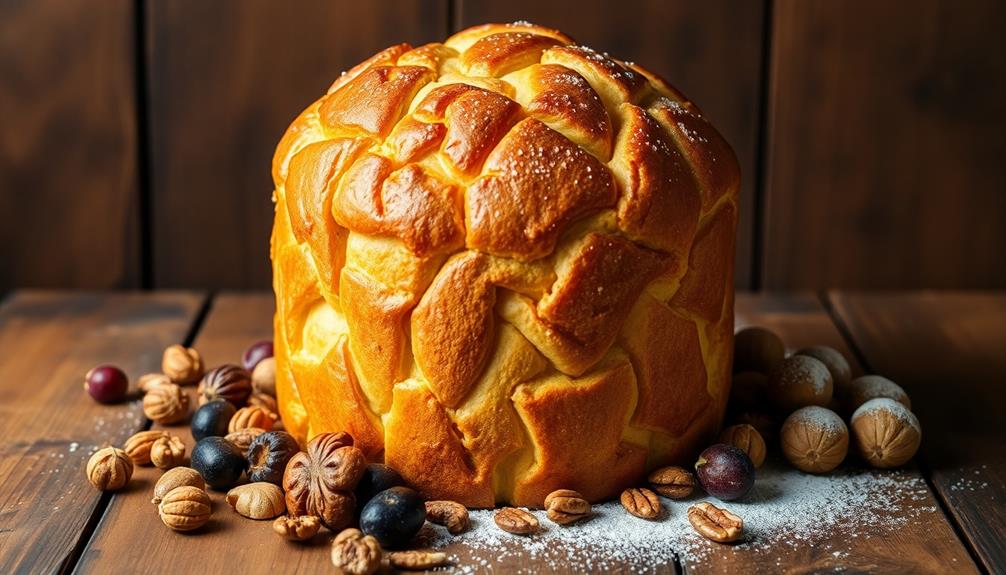You'll love sinking your teeth into a slice of panettone, the fluffy, buttery Italian Christmas bread that's bursting with festive flavors of citrus and spice. This beloved holiday staple has enchanted palates for centuries, originating in Milan during the 15th century. With a rich history and cherished cultural significance, panettone has become a centerpiece for family gatherings, fostering connections and joyful memories. From the multi-step rising process to the perfect balance of sweetness, each bite promises a taste of Italy's holiday traditions. Discover more about this timeless charm and what makes panettone a true delight for the senses.
Key Takeaways
- Panettone is a traditional Italian sweet bread with a fluffy texture, known for its rich, buttery taste and festive notes of citrus and spice.
- The origins of panettone can be traced back to 15th-century Milan, where it became a beloved holiday staple and symbol of the festive season.
- Baking panettone involves a meticulous process with multiple rising stages, ensuring the perfect balance of texture and flavor.
- Homemade panettone allows for customization and creativity, reflecting the cherished tradition of this holiday bread in Italian culture.
- The ritual of slicing and sharing panettone fosters connections among family and friends, creating lasting memories and a sense of comfort and joy.
History
Panettone's origins trace back to Milan, Italy, where it emerged as a cherished holiday tradition in the 15th century. This tall, dome-shaped sweet bread was first baked by a young apprentice who, against all odds, created a delightful treat for his boss's Christmas celebration.
The unique recipe called for a rich, buttery dough studded with dried fruits and candied citrus peels.
Over the centuries, panettone's fame spread throughout Italy and beyond. Families eagerly awaited its arrival each December, savoring the bread's melt-in-your-mouth texture and festive flavors.
Today, this iconic Italian delight remains a beloved symbol of the holiday season, gracing tables from Rome to New York. Whether enjoyed on its own or paired with a steaming cup of coffee, panettone continues to spread joy and bring people together during the most wonderful time of the year.
Recipe
Panettone, the iconic Italian sweet bread, is a beloved holiday treat that has captured the hearts of many around the world. Its fluffy, golden crumb and distinctive flavor make it a true delight to savor.
The process of making panettone is a labor of love, requiring patience and attention to detail. However, the end result is well worth the effort, as the rich, buttery taste and aroma of this delectable bread are sure to impress your family and friends.
Ingredients:
- 1 cup (250 ml) warm milk
- 1 tablespoon (15 ml) active dry yeast
- 1/2 cup (100 g) granulated sugar
- 4 1/2 cups (560 g) all-purpose flour
- 1 teaspoon (5 ml) salt
- 4 large eggs
- 1 cup (230 g) unsalted butter, softened
- 1 cup (160 g) mixed dried fruit (such as raisins, candied citrus peel, and apricots)
- 1 tablespoon (15 ml) vanilla extract
Cooking Instructions:
In a large mixing bowl, combine the warm milk, yeast, and 2 tablespoons (25 g) of the sugar. Let the mixture sit for 10 minutes, until the yeast is activated and foamy.
Add the remaining sugar, flour, and salt, and mix until a shaggy dough forms. Turn the dough out onto a lightly floured surface and knead for about 10 minutes, until it becomes smooth and elastic.
Place the dough in a greased bowl, cover, and let it rise for 1 hour, or until doubled in size. Punch down the dough to release any air bubbles, then fold in the eggs, butter, dried fruit, and vanilla extract.
Knead the dough until all the ingredients are well incorporated. Transfer the dough to a greased panettone mold or a deep, round baking pan with high sides. Cover and let the dough rise for another 1-2 hours, or until it has nearly reached the top of the pan.
Preheat the oven to 350°F (180°C). Bake the panettone for 45-60 minutes, or until a toothpick inserted into the center comes out clean. Allow the panettone to cool completely before slicing and serving.
When making panettone, it's important to take your time and not rush the rising process. The long, slow fermentation is what gives this bread its unique texture and flavor.
Additionally, be sure to use high-quality ingredients, as they'll greatly impact the overall taste and quality of the final product.
Cooking Steps
First, you'll need to proof the yeast in some warm milk.
Once it's nice and bubbly, knead the dough for about 10 minutes until it's smooth and elastic.
Then, let the dough rise in a warm spot until it's doubled in size.
Step 1. Proof Yeast in Warm Milk
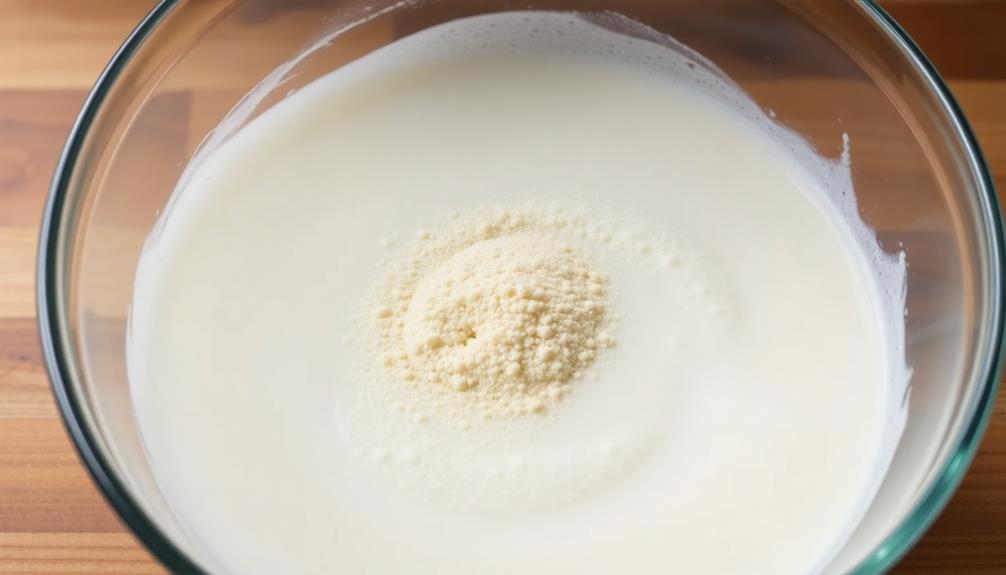
To begin the proofing process, you'll need to dissolve the yeast in warm milk. Make sure the milk is just slightly warm, not hot – you don't want to kill the yeast! Add the yeast and stir gently until it's fully dissolved. This activates the yeast, allowing it to do its magic and produce carbon dioxide gas.
After mixing the yeast and milk, you'll need to let the mixture sit for about 10 minutes. During this time, the yeast will start to bubble and foam, signaling that it's alive and ready to work. You might even see tiny bubbles forming on the surface – that's a good sign!
Once the yeast is proofed, you can add it to the rest of your panettone dough. The proofed yeast will help the dough rise and give your final bread a wonderful, airy texture.
Just follow the recipe instructions from there, and you'll be well on your way to baking a delicious, homemade panettone!
Step 2. Knead Dough for 10 Minutes

With the yeast proofed and ready, you can now start kneading the dough. Gather the dough on a lightly floured surface and get ready for a fun workout! Knead the dough with the palms of your hands, pushing it away from you, then fold it back towards you.
Repeat this motion for about 10 minutes, until the dough becomes smooth and elastic. As you knead, you'll feel the dough transform from a sticky, shaggy mess into a beautiful, silky ball. Keep a light touch and don't be afraid to add a sprinkle of flour if the dough starts to stick.
The key is to work the dough gently, but with determination, until it develops a lovely, springy texture. Kneading is an essential step in making perfect panettone. It develops the gluten, which gives the bread its signature light and airy crumb.
Step 3. Proof Dough in Warm Location
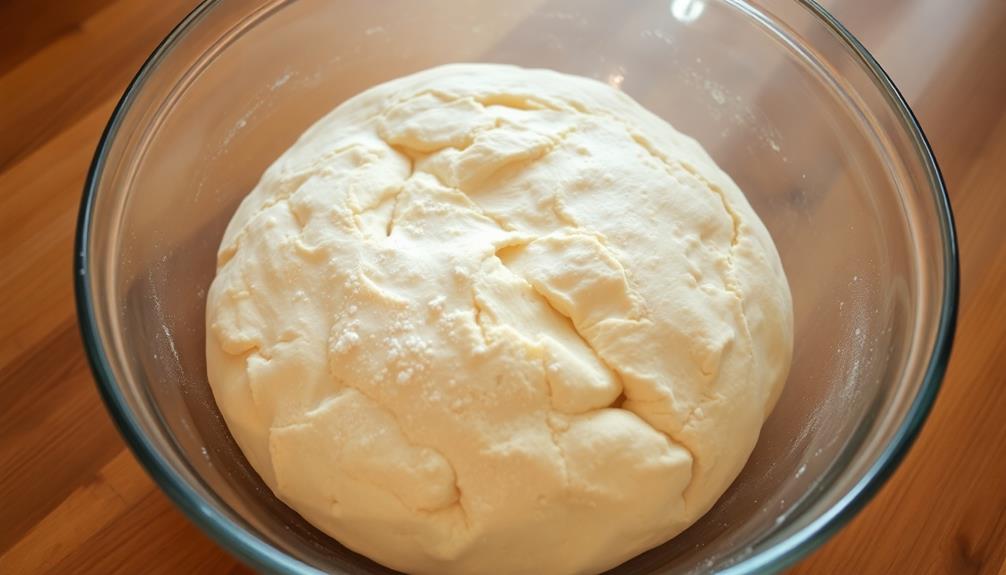
Once the dough has been kneaded to perfection, the next step is to let it rise.
Find a warm, cozy spot in your kitchen for the dough to proof. This could be on top of the oven, near a sunny window, or even inside your oven with the light on.
Gently place the dough in a large, lightly greased bowl and cover it with a clean, damp towel.
Now, be patient and let the dough work its magic! Over the next 1-2 hours, the dough will double in size as the yeast does its job.
You'll know it's ready when you gently poke the dough, and the indent remains.
Resist the urge to peek – every time you lift the towel, you let out precious warmth and moisture, slowing the proofing process.
Once the dough has risen, you're ready for the next exciting step: shaping your panettone!
Get ready to create a delicious holiday treat.
Step 4. Bake at 350°F for 30 Minutes
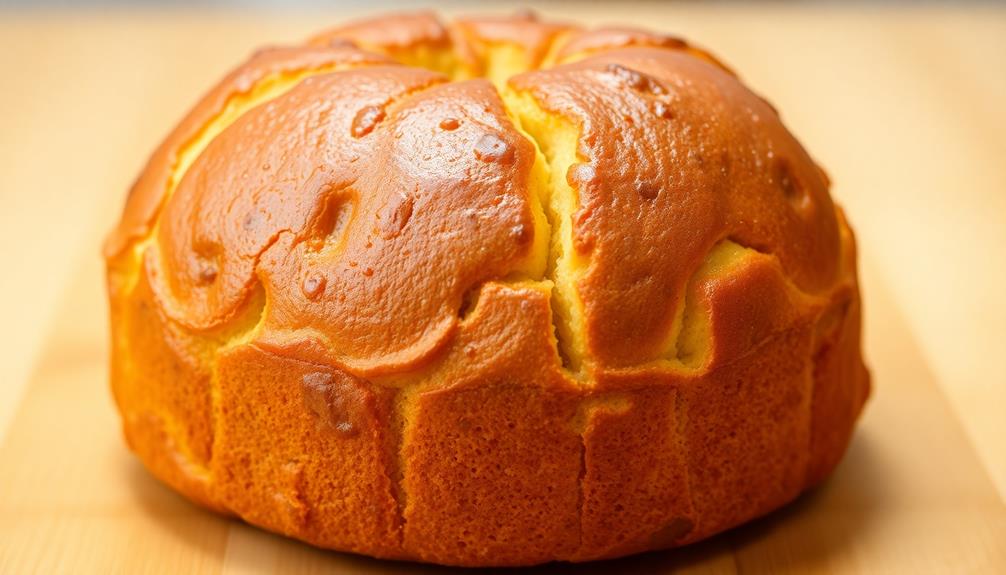
Preheat your oven to 350°F. It's time to bake your delicious panettone! This classic Italian sweet bread will fill your home with the most mouthwatering aroma.
Once your oven is ready, carefully place the panettone dough into the oven. Bake it for 30 minutes, keeping a close eye to ensure it doesn't brown too quickly. The top should develop a lovely golden crust, while the inside remains soft and fluffy.
Use the toothpick test to check for doneness – insert a toothpick into the center of the panettone. If it comes out clean, your bread is ready!
Be careful when removing the panettone from the oven, as the pan will be very hot. Use oven mitts to transfer it to a wire rack and let it cool completely before slicing. This step is crucial, as it allows the bread to finish baking and the flavors to meld together.
Once cooled, your panettone is ready to be enjoyed by the whole family! Buon appetito!
Step 5. Remove the Panettone From Oven
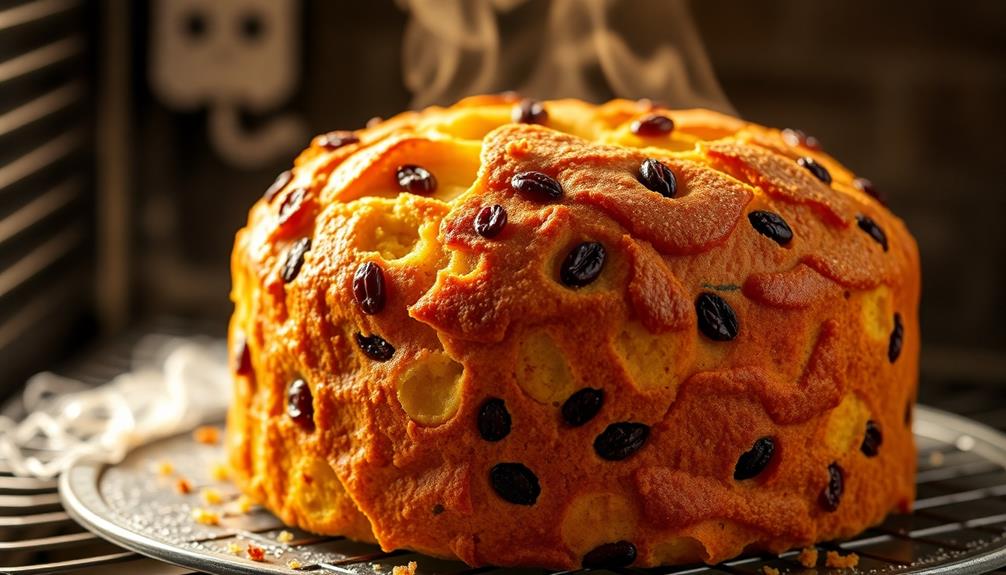
After the 30-minute baking time, carefully remove the panettone from the oven using oven mitts. The sweet aroma of the freshly baked bread will fill the air, making your mouth water in anticipation.
Gently place the panettone on a cooling rack, being mindful not to drop it or let it tilt to the side. The top of the panettone should have a beautiful golden-brown crust, with a soft, fluffy interior.
Take a moment to admire your handiwork – you've just created a traditional Italian holiday treat!
Once the panettone has cooled for about 15 minutes, you can start slicing into it. Use a serrated knife and cut the panettone into thick, generous slices.
Serve it warm, with a pat of butter or a drizzle of honey, if desired. Your family will be delighted to enjoy this delicious, homemade panettone.
Savor every bite and cherish the sweet memories made in the kitchen together.
Final Thoughts
Panettone's allure extends beyond its delectable taste. This classic Italian bread captivates hearts and minds, becoming a cherished tradition during the holiday season. Its fluffy texture and fragrant notes of citrus and spice evoke warm memories, drawing families together in joyful celebration.
Beyond satisfying the palate, panettone nourishes the soul. Slicing into this golden loaf becomes a ritual, a moment to savor the simple pleasures of life. Whether sharing a slice with a loved one or indulging in a solo indulgence, the experience is one of comfort and delight.
As the new year approaches, panettone's enduring appeal serves as a reminder to embrace the wonder of the present. Its timeless charm encourages us to slow down, appreciate the small moments, and cultivate traditions that bring us closer together.
In the end, panettone's true magic lies not just in its taste, but in its power to inspire cherished memories and foster meaningful connections.
Frequently Asked Questions
What Is the Best Way to Store Leftover Panettone?
Wrap the leftover food tightly in plastic or foil to prevent it from drying out. Store it at room temperature for up to 5 days or in the fridge for up to a week. Avoid freezing, as it can alter the texture.
Can Panettone Be Frozen for Later Consumption?
Yes, you can freeze leftover panettone for later enjoyment. Just wrap it tightly in plastic wrap or aluminum foil, and it'll stay fresh in the freezer for up to 3 months.
How Long Does Panettone Typically Stay Fresh?
Typically, freshly baked goods like this stay fresh for 3-5 days at room temperature. If you want it to last longer, you can freeze it for up to 3 months. Just be sure to thaw it before enjoying.
What Are Some Unique Variations of Traditional Panettone?
Unique variations of traditional dishes can be quite interesting! You might find panettone with unexpected flavors like chocolate, citrus, or even savory ingredients. Get creative and explore the possibilities beyond the classic version.
Can Panettone Be Used in Other Dessert Recipes?
You can definitely incorporate panettone into other desserts! Its rich, buttery texture and sweet flavors make it a versatile ingredient for cakes, bread puddings, trifles, and even ice cream. Get creative and see what delicious treats you can whip up with it.
